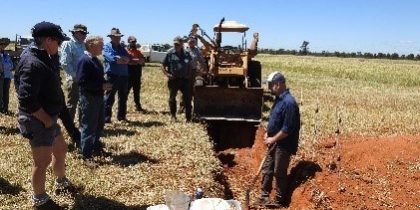Best practice pasture management has been linked to improved soil health in agricultural landscapes. To investigate this, we assessed the soil chemistry and biology of four different land management systems: alley plantings, pasture cropping, standard pastures, and native woodland. The different systems were on the properties of five landholders and a state forest in Boree Creek.
Comparing the soil of these different management systems provided practical information to facilitate discussions on the impact of each system based on various soil parameters.
Through a workshop for local landholders, we detailed the various chemical, physical and biological attributes of soils, and the importance of pastures in building soil organic matter. Soil test results were collated and presented to the workshop attendees. Comparisons were made with historical soil data across the district, including the link to underlying geology. We then spent time investigating a soil pit at Graham and Amanda Strong’s property, demonstrating practical field-based soil tests which farmers can use to assess soil health.







